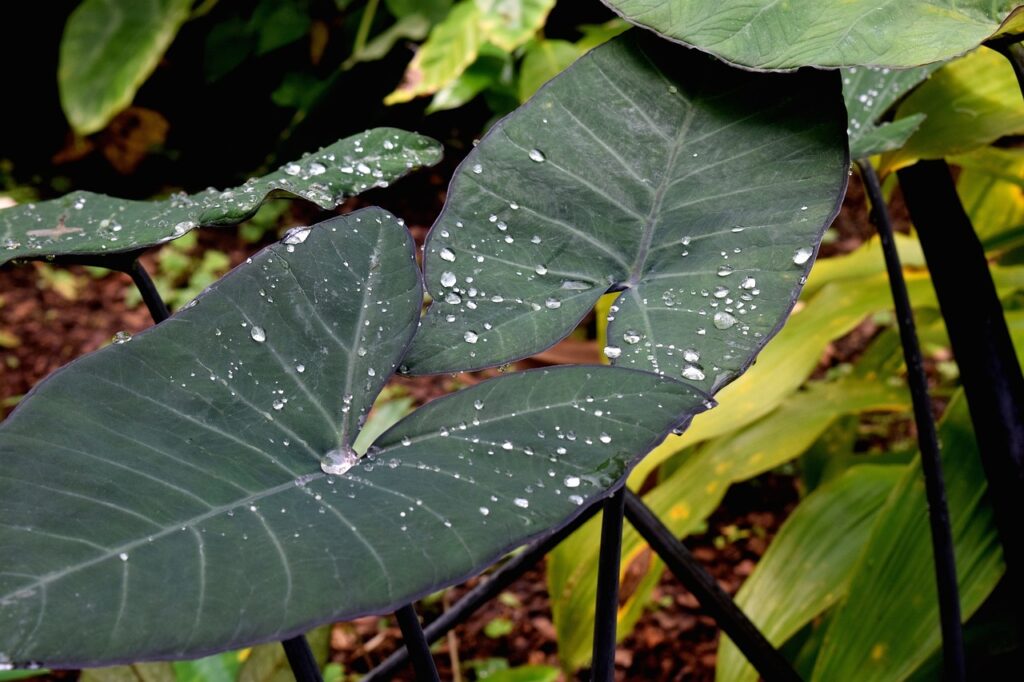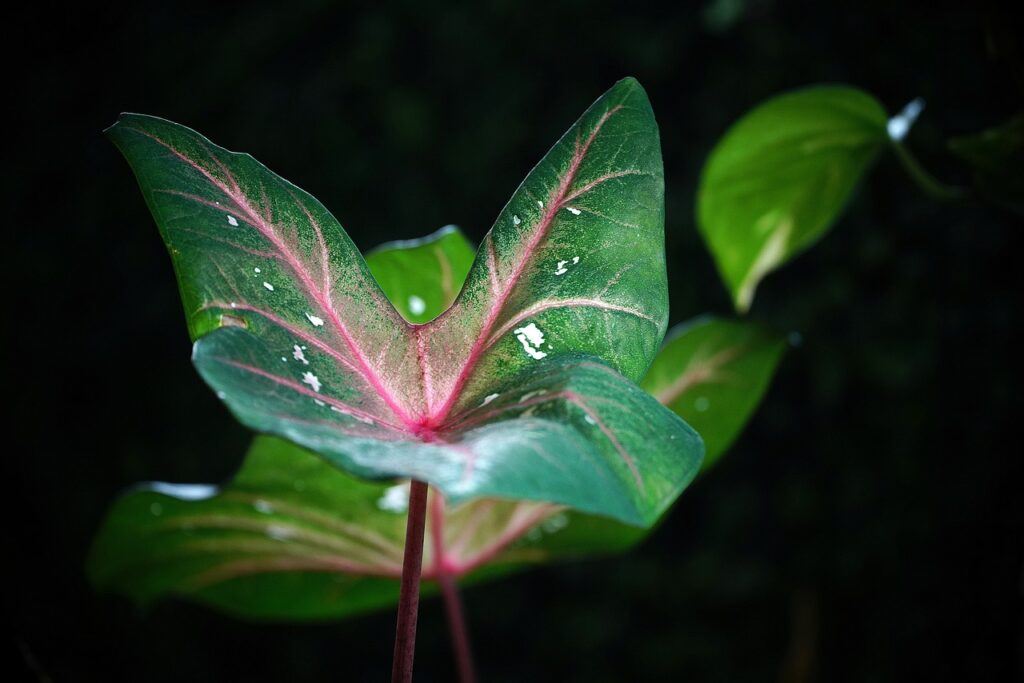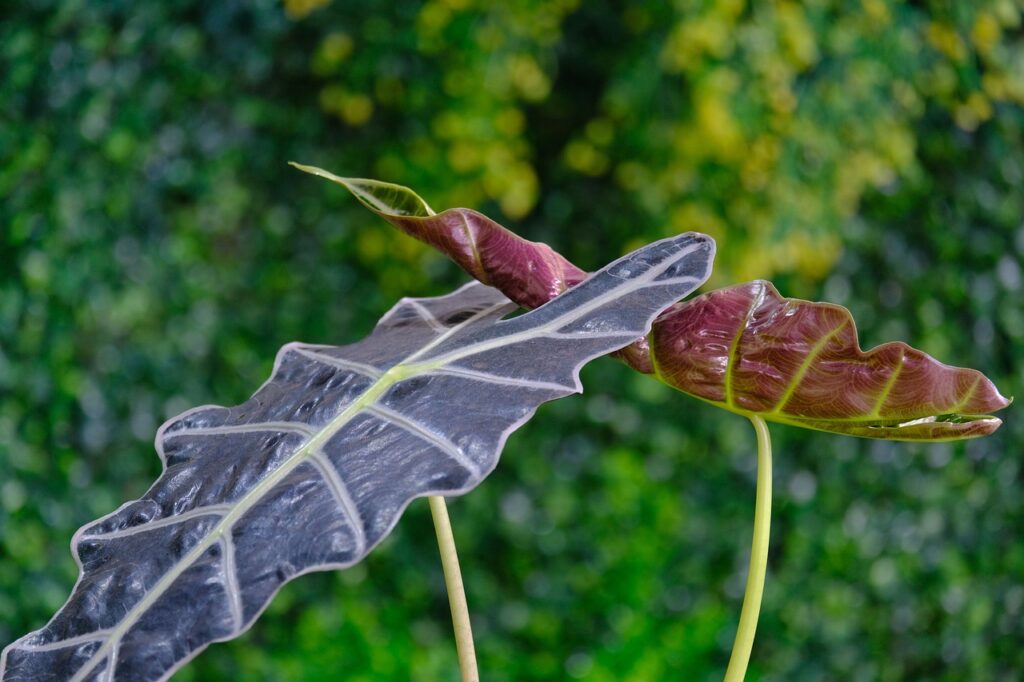Table of Contents
What’s an elephant ear plant?
Elephant ear plants are a tropical plant species, also known as colocasia or taro, known for their large, paddle-shaped leaves that resemble elephant ears. They are native to Southeast Asia and are a popular ornamental plant for gardens, patios, and even indoor spaces. They typically grow to be around 2-4 feet tall and have a similar spread.
They prefer warm, humid climates and can be grown in both sun and shade. They are also commonly grown for their edible tubers and as a staple food in many cultures.
What makes them so unique?
Elephant ear plants are unique for several reasons:
Leaf shape: The most notable feature of elephant ear plants is the shape of their leaves. The leaves are large, paddle-shaped and resemble the ears of an elephant, which is where the plant gets its name.
Size: Elephant ear plants can grow to be quite large, with some varieties reaching up to 8 feet tall. They also have a wide spread, making them a dramatic addition to any garden or indoor space.
Color: The leaves of elephant ear plants come in a variety of colors, including green, black, purple, and even variegated. This adds an interesting visual element to the plant.
Adaptability: Elephant ear plants can adapt to a variety of growing conditions. They can be grown in full sun or partial shade, and can even be grown in containers. They are also tolerant of a wide range of soil types, as long as they are kept consistently moist.
Edibility: Elephant ear plants are also grown for their edible tubers. The tubers are rich in carbohydrates and are a staple food in many cultures, particularly in Asia and Africa.
Variety: Elephant ear plants come in many varieties, from small to large, with different leaf colors and patterns. This allows for a wide range of options for gardeners and indoor plant enthusiasts.
Overall, the combination of their large, visually striking leaves, their adaptability and hardiness, and their versatility in terms of color and variety, makes Elephant ear plants unique in the plant world.
Tips For Growing Elephant Ear Plants
Elephant ear plants, also known as taro or colocasia, are a tropical plant that can be grown both indoors and outdoors. They are known for their large, paddle-shaped leaves that resemble elephant ears. Here are some tips for growing elephant ear plants:
Planting: Elephant ear plants prefer moist, well-drained soil that is rich in organic matter. They should be planted in a location that receives partial shade to full sun, depending on the variety.
Watering: Elephant ear plants require consistent moisture and should be watered regularly, especially during the growing season. Avoid letting the soil dry out completely, as this can cause the leaves to wilt.
Fertilizing: Elephant ear plants benefit from regular fertilization during the growing season. Use a balanced, slow-release fertilizer or a liquid fertilizer every 4-6 weeks.
Pest and disease control: Elephant ear plants are relatively pest- and disease-free. However, they can be susceptible to snails and slugs, which can be controlled with bait or copper strips.
Overwintering: Elephant ear plants are tropical plants and are not cold-hardy. If you live in a colder climate, you will need to dig up the bulbs and store them indoors for the winter.
Propagation: Elephant ear plants can be propagated by dividing the bulbs or by taking stem cuttings.
By following these tips, you can successfully grow and enjoy elephant ear plants in your garden.
How to take care of elephant ear plants
Elephant ear plants are relatively easy to care for, but they do have some specific requirements that need to be met in order to thrive. Here are some tips on how to take care of elephant ear plants:
Location: Elephant ear plants prefer a location that receives partial shade to full sun, depending on the variety. They are not cold-hardy, so if you live in a colder climate, it is best to grow them in containers that can be brought indoors during the winter.
Light: Elephant ear plants prefer partial shade to full sun, depending on the variety. They should be placed in a location where they will receive the appropriate amount of light for their specific variety.
Soil: Elephant ear plants prefer moist, well-drained soil that is rich in organic matter. They are tolerant of a wide range of soil types, as long as they are kept consistently moist.
Pot: Elephant ear plants can be grown in pots or in the ground. If grown in pots, make sure to use a container with drainage holes to prevent water from standing in the bottom.
Watering: Elephant ear plants require consistent moisture and should be watered regularly, especially during the growing season. Avoid letting the soil dry out completely, as this can cause the leaves to wilt. Watering can be done by flooding the area around the plant and allowing it to drain.
Fertilizing: Elephant ear plants benefit from regular fertilization during the growing season. Use a balanced, slow-release fertilizer or a liquid fertilizer every 4-6 weeks.
Pest and Disease Control: Elephant ear plants are relatively pest- and disease-free. However, they can be susceptible to snails and slugs, which can be controlled with bait or copper strips.
Overwintering: Elephant ear plants are tropical plants and are not cold-hardy. If you live in a colder climate, you will need to dig up the bulbs and store them indoors for the winter.
Air: Elephant ear plants require good air circulation to thrive. Make sure to place them in an area where they will receive good airflow, and avoid overcrowding them with other plants.
Propagation: Elephant ear plants can be propagated by dividing the bulbs or by taking stem cuttings.
By providing your elephant ear plants with the right light, soil, pot, fertilizer, and air, you can ensure that they will thrive and continue to provide striking foliage for many seasons to come. It’s also important to note that overwatering can cause the leaves to yellow, and underwatering can cause the leaves to wilt, so make sure to keep an eye on the soil moisture.
Common pests and diseases
Elephant ear plants are generally considered to be relatively pest- and disease-free. However, they can be susceptible to a few common pests and diseases, such as:
Snails and slugs: These pests can cause damage to the leaves of elephant ear plants by eating holes in them. They can be controlled with bait or copper strips.
Aphids: These small insects can suck the sap from the leaves of elephant ear plants, causing them to yellow and wilt. They can be controlled with insecticidal soap or neem oil.
Fungal diseases: Elephant ear plants can be susceptible to fungal diseases such as leaf spot and powdery mildew. These diseases can cause discoloration and wilting of the leaves. They can be controlled with a fungicide and by providing good air circulation around the plants.
Root rot: Root rot is a fungal disease that can occur when the soil is too wet, or when the plant is overwatered. It can cause the leaves to turn yellow and wilt, and can ultimately kill the plant. To avoid root rot, make sure to plant elephant ear plants in well-drained soil, and avoid overwatering.
- Yellow leaves: If the soil is consistently too wet, the roots of the plant can begin to rot, causing the leaves to turn yellow. To avoid this, make sure to plant elephant ear plants in well-drained soil, and avoid overwatering.
- Brown leaves: Elephant ear plants can be sensitive to direct sunlight, especially if they are not acclimated to it. Brown leaves can be a sign of sunburn and should be moved to a location with filtered light.
By identifying and treating pests and diseases early, you can help keep your elephant ear plants healthy and thriving. Regular inspection of the plants and keeping an eye out for any unusual symptoms, such as discoloration, wilting, or holes in the leaves, is crucial in preventing any damage.
The Final Note
In conclusion, elephant ear plants are a unique and striking addition to any garden or indoor space, known for their large, paddle-shaped leaves that resemble elephant ears. They are relatively easy to care for, but they do have some specific requirements that need to be met in order to thrive. Providing them with the right light, soil, pot, fertilizer, and the air is crucial for their growth.
They can be susceptible to common pests and diseases, such as snails and slugs, aphids, fungal diseases, and root rot. Yellow or brown leaves can be a sign of a problem and should be addressed promptly to prevent further damage to the plant. By following these tips, you can successfully grow and enjoy elephant ear plants in your garden or indoor space.





